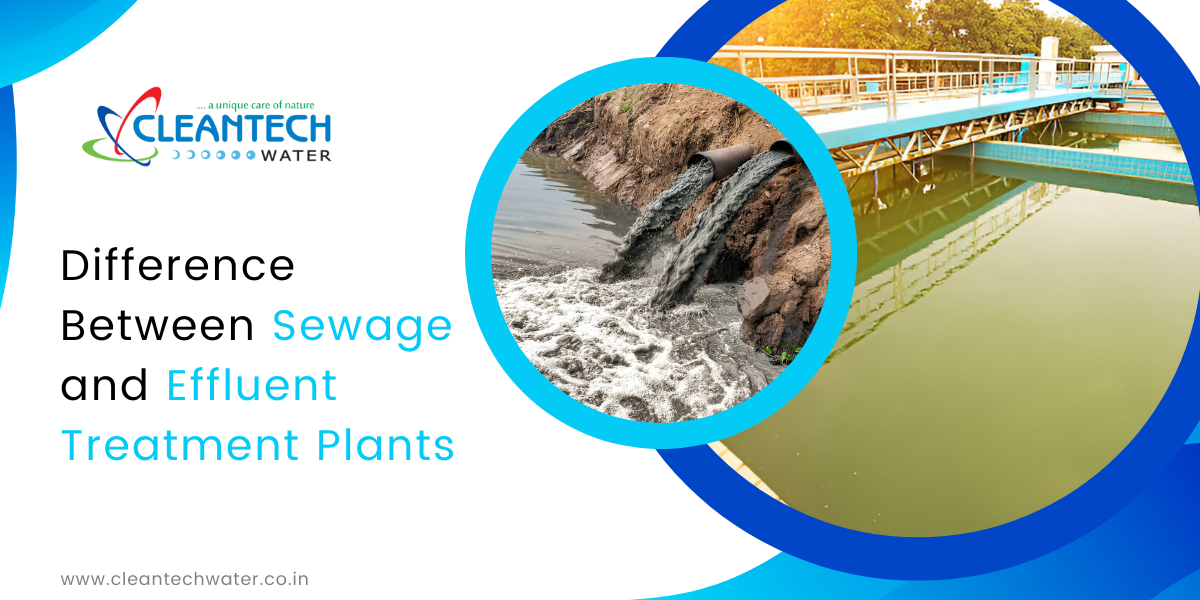Sewage and effluent treatment plants play a critical role in managing the world’s water resources. As India continues to grow industrially and urbanise rapidly, the need for effective wastewater management solutions is more crucial than ever. Both sewage treatment plants (STPs) and effluent treatment plants (ETPs) serve this purpose, but they address different types of wastewater and have distinct functionalities.
This article explores the differences between sewage and effluent plants, helping businesses and communities understand their roles in wastewater management.

Sewage Treatment Plants (STPs)
Definition and Primary Function
Sewage treatment plants are designed to treat sewage or wastewater generated by residential, commercial, and sometimes industrial activities. Their primary purpose is to clean the sewage before releasing it into natural water bodies, minimising its harmful environmental impact. The treated water can also be reused for non-potable applications like irrigation, landscaping, or industrial cooling. STPs remove contaminants such as organic matter, suspended solids, and harmful microorganisms, ensuring public health and environmental safety.
Types of Sewage Treated
Sewage treatment plants typically deal with domestic wastewater, which includes water from households, schools, and office buildings. However, in some cases, STPs may also treat light industrial wastewater. The key difference lies in the composition of the sewage treated. Domestic sewage mainly contains biodegradable organic matter, nutrients, and microorganisms. Light industrial wastewater may contain small amounts of chemicals or non-biodegradable substances.
Effluent Treatment Plants (ETPs)
Definition and Primary Function
Effluent treatment plants focus on treating wastewater from industrial processes. These plants are specifically designed to handle industrial effluents, which often contain a variety of harmful chemicals, heavy metals, and non-biodegradable substances that can pose significant environmental and health risks if not properly treated. The primary function of ETPs is to remove these toxic pollutants from industrial wastewater before it is either reused or discharged into the environment.
Focus on Industrial Wastewater Treatment
Unlike sewage plants, effluent treatment plants are tailored to the specific needs of various industries. The nature of the effluent varies widely depending on the industry. This variability means that ETPs often require more complex treatment processes to meet environmental compliance standards and ensure the treated water is safe for disposal or reuse.
Key Differences Between STPs and ETPs
1. Source of Wastewater
One of the most significant differences between sewage and effluent treatment plants lies in the source of wastewater they handle.
- Sewage Treatment Plants: STPs primarily treat wastewater from residential, commercial, and municipal sources. This wastewater comes from households, offices, schools, and other public facilities where water is used for activities like bathing, washing, and cooking. Domestic sewage typically consists of organic matter, nutrients, and microorganisms, and is generally less toxic than industrial wastewater.
- Effluent Treatment Plants: These are designed specifically to treat industrial wastewater. The effluent produced by industries, including chemical plants, textile mills, pharmaceuticals, and manufacturing units, is often contaminated with hazardous chemicals, heavy metals, and non-biodegradable substances. This makes the treatment process more complex and industry-specific compared to the relatively straightforward process in STPs.
2. Composition of Wastewater
The composition of the wastewater treated by STPs and ETPs is a critical factor that differentiates these systems.
- Sewage Treatment Plants: The wastewater entering STPs is primarily domestic in nature. It contains biodegradable organic matter, nutrients like nitrogen and phosphorus, and suspended solids. These components are easier to break down biologically through various treatment stages, such as aerobic and anaerobic digestion.
- Effluent Treatment Plants: The wastewater treated in ETPs varies widely depending on the industry. It often contains toxic substances such as heavy metals (lead, mercury, cadmium), organic chemicals (solvents, dyes, detergents), and non-biodegradable pollutants. The treatment process must be designed to neutralise or remove these contaminants, making ETPs more specialised than STPs.
3. Treatment Base
The treatment methods employed by sewage and effluent treatment plants are also different, as they are tailored to the specific composition of the wastewater.
- Sewage Treatment Plants: STPs rely mainly on biological treatment methods. This involves using microorganisms to break down organic matter in wastewater. Primary, secondary, and tertiary treatments are employed to filter, digest, and further purify the water before it is released into natural water bodies. In some cases, STPs also include chemical disinfection to ensure the treated water meets regulatory standards.
- Effluent Treatment Plants: ETPs often require more advanced treatment processes, including physical, chemical, and biological methods. In addition to biological treatment, ETPs may use coagulation, filtration, neutralisation, and chemical precipitation to remove harmful contaminants. Depending on the industry, some ETPs may even require advanced oxidation processes, membrane filtration, or reverse osmosis to ensure industrial wastewater is safe for discharge or reuse.
4. Location
The location of sewage and effluent treatment plants is another distinguishing factor.
- Sewage Treatment Plants: STPs are typically located near urban areas or residential zones where large populations generate domestic sewage. These plants are integrated into municipal wastewater management systems, and their proximity to cities allows them to treat large volumes of sewage efficiently.
- Effluent Treatment Plants: ETPs are usually situated near industrial zones or within the premises of factories and manufacturing units. Their location depends on the proximity to the source of the industrial effluent, allowing for effective on-site treatment. Some industries are mandated by environmental regulations to install ETPs on-site, ensuring the wastewater generated is treated before it is discharged.
5. Application
The applications of sewage and effluent treatment plants differ based on the type of wastewater they treat and their end goals.
- Sewage Treatment Plants: STPs serve residential and municipal applications. The treated water is often discharged into rivers, lakes, or other water bodies, where it is safe for aquatic life and the environment. In some cases, treated sewage water is reused for non-potable purposes like irrigation, landscaping, or industrial cooling.
- Effluent Treatment Plants: ETPs are used primarily in industrial applications. The goal is to remove hazardous substances from industrial wastewater to prevent environmental contamination and health risks. The treated water can be reused in the industry itself, or safely discharged into the environment after meeting strict regulatory standards. ETPs are also essential in industries where water recycling is necessary to conserve resources.
6. Mechanisms
The operational mechanisms of sewage and effluent treatment plants also highlight their differences.
- Sewage Treatment Plants: STPs use a combination of physical, biological, and sometimes chemical processes to treat sewage. The treatment usually begins with primary processes like screening and sedimentation, followed by secondary biological treatments such as activated sludge or trickling filters. The final tertiary stage involves disinfection to kill any remaining pathogens.
- Effluent Treatment Plants: ETPs often employ more complex treatment mechanisms, especially when dealing with highly toxic industrial wastewater. This can include multi-stage filtration, chemical neutralisation, biological processes, and advanced oxidation techniques. Industries like pharmaceuticals, textiles, and food processing may need specific treatments tailored to their effluent’s characteristics.
7. Regulatory Compliance
Both sewage and effluent treatment plants are governed by regulatory standards, but the stringency of these regulations varies.
- Sewage Treatment Plants: In India, STPs are regulated by the Central Pollution Control Board (CPCB) under the Environment Protection Act, of 1986. These regulations are focused on ensuring the treated water meets certain standards before it is discharged into water bodies. The effluent quality parameters for STPs include biochemical oxygen demand (BOD), chemical oxygen demand (COD), total suspended solids (TSS), and coliform levels.
- Effluent Treatment Plants: The regulations for ETPs are much more stringent due to the hazardous nature of industrial effluents. Each industry is required to comply with specific discharge norms based on the type of pollutants in their wastewater. For example, industries like textiles, pharmaceuticals, and tanneries must meet different effluent standards. Non-compliance can result in severe penalties, including closure of the facility, as outlined by the Water (Prevention and Control of Pollution) Act, 1974.
Book a No-Obligation Consultation for Expert Advice!
Frequently Asked Questions
Why are ETPs crucial for industries?
Effluent treatment plants are essential for industries because they treat wastewater containing hazardous chemicals, heavy metals, and other pollutants. Without proper treatment, this wastewater can severely harm the environment and violate regulatory standards, leading to penalties.
Can treated water from ETPs be reused?
Yes, treated water from ETPs can be reused, depending on the level of treatment and the industry’s needs. After proper treatment, this water can be recycled for industrial processes, irrigation, or even discharged into natural water bodies safely.
Are industries required to install ETPs by law?
Yes, many industries are required by law to install ETPs on-site to treat their effluent before releasing it into the environment. Failure to comply with regulations can result in fines, penalties, or the suspension of operations.
How do STPs and ETPs contribute to environmental sustainability?
Sewage and effluent treatment plants prevent untreated wastewater from polluting natural water sources. By treating wastewater and removing harmful substances, both plants protect ecosystems, preserve public health, and contribute to sustainable water management.
What are the maintenance requirements for STPs and ETPs?
Both STPs and ETPs require regular maintenance to function efficiently. STPs typically need routine cleaning of filters and tanks, while ETPs require more complex maintenance due to chemical treatments and the potential buildup of hazardous substances in equipment.
How are the treated effluents from ETPs disposed of?
After treatment, effluents from ETPs can either be discharged into water bodies, provided they meet regulatory standards or reused in industrial processes. Some industries implement zero liquid discharge (ZLD) systems to recycle all wastewater without discharging any into the environment.
What are the environmental risks of not using STPs or ETPs?
Failure to use sewage and effluent treatment plants can lead to severe environmental pollution, including contamination of rivers, lakes, and groundwater. Untreated wastewater can also cause the death of aquatic life, soil degradation, and public health hazards due to harmful pathogens and chemicals.
How do industries choose the right ETP for their operations?
Industries choose the right effluent treatment plant based on the type and volume of wastewater generated. Factors like the presence of hazardous chemicals, heavy metals, and organic contaminants determine the specific treatment methods required. Consulting with experts to design a customized ETP ensures compliance with regulatory standards and efficient wastewater treatment.
We Provide Both Sewage and Effluent Treatment Plant Solutions
Managing wastewater efficiently is essential for both residential and industrial sectors. Whether you’re dealing with domestic sewage from homes and communities or industrial effluent with hazardous chemicals, Cleantech Water offers tailored solutions to meet your specific needs.
Our sewage treatment plants are designed to treat municipal and domestic wastewater, ensuring safe disposal and water reuse. For industries, our advanced effluent treatment plants handle complex pollutants, ensuring regulatory compliance and protecting the environment.
With a commitment to sustainability, we help you reduce your environmental footprint while optimizing wastewater treatment processes. From design to installation and ongoing maintenance, our team provides end-to-end support to ensure your plant operates efficiently.
Don’t risk non-compliance or environmental damage by overlooking proper wastewater management. Reach out today at +91-9099915539 to learn more about how our STP and ETP solutions can safeguard your operations and contribute to a cleaner, healthier world for future generations!

